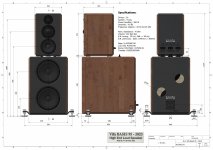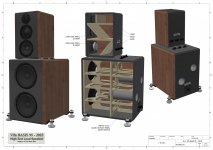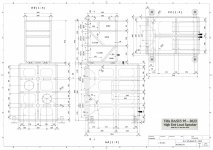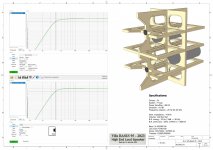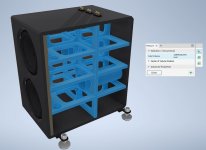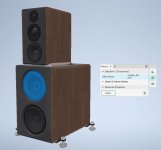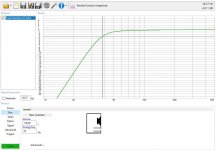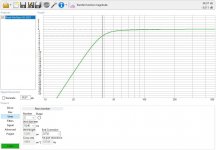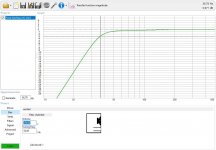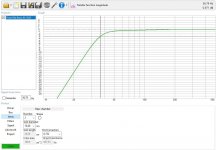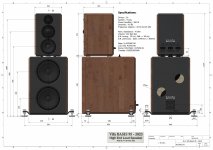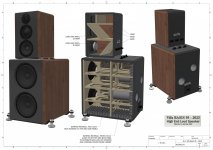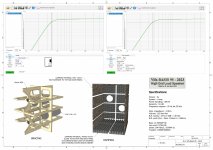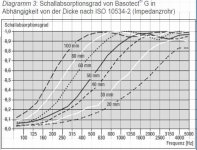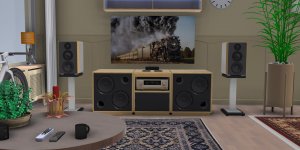No problem to make smooth perfect bracings Turbowatch2.
This is part of our hobby. 👌
I have no CNC machine. 😛
This is part of our hobby. 👌
I have no CNC machine. 😛
You may have the idea of some kind of storm going on inside your bass cabinet. To tell you the truth, there is very little air moving inside. Air speed at the walls is zero. So there is no need to cut away as much material as possible from the braces. Rounding the edges is complete waste of time and tools. An the other side, keeping as much material as possible for the braces, makes a lot of sense. So cut away as little as needed instead of as much as you can. Air pressure needs very little holes to keep pressure constant inside the whole box. Think of a boot on the water, just a relative small hole will sink it in very short time. Now imagine air instead... puff and gone! You can not beat a simple board with some round holes, whatever you design. Thin, long braces will even resonate like a string!
Since 3-D designing and CNC cutting has become so common today, many constructions I see, DIYS or professional, get more and more complicated. Often loosing sight of the real function.
This may be caused by pictures of finite element modeling (FEM), ,which usually seems to be very complicated to the eye. Even as a simple 3-D program has nothing to do with FEM at all.
"Fancy" and marketing come to my mind.
If you want to sell something and you don't have a FEM program, don't know how it works or how it can fit your application, at least make your product look like you used FEM and brag about it... I wait for the day that someone starts to sell FEM modeled toast bread and FEM mixed pudding.
Stir in some "trade secret" voodoo and you got your tasty serve of snake oil.
So maybe go back to the roots and ask what you really want for a speaker cabinet. Resonance free walls, that's all. Maybe some diffusion for standing waves. Done!
PS if you ask why commercial products do not use this simple approach any more, the simple answer is "too much work" and the above causes.
Since 3-D designing and CNC cutting has become so common today, many constructions I see, DIYS or professional, get more and more complicated. Often loosing sight of the real function.
This may be caused by pictures of finite element modeling (FEM), ,which usually seems to be very complicated to the eye. Even as a simple 3-D program has nothing to do with FEM at all.
"Fancy" and marketing come to my mind.
If you want to sell something and you don't have a FEM program, don't know how it works or how it can fit your application, at least make your product look like you used FEM and brag about it... I wait for the day that someone starts to sell FEM modeled toast bread and FEM mixed pudding.
Stir in some "trade secret" voodoo and you got your tasty serve of snake oil.
So maybe go back to the roots and ask what you really want for a speaker cabinet. Resonance free walls, that's all. Maybe some diffusion for standing waves. Done!
PS if you ask why commercial products do not use this simple approach any more, the simple answer is "too much work" and the above causes.
In fewer words.
No I have not the idea that any storm is inside my cabinet, don't worry about that 😉.
I like to break edges 😀.
Also @ entry of the ports.
No I have not the idea that any storm is inside my cabinet, don't worry about that 😉.
I like to break edges 😀.
Also @ entry of the ports.
Hi Turbo,One problem with ports is the air velocity. The higher it gets, the more losses. When the air gets turbulent, "port noise" will be audible.
So the port diameter should be in a reasonable relationship to the cone area and maximum excursion of the driver.
As your drivers are quite conservative in excursion, you should get away with ports on the smaller side.
Have a look at WinISD: The rear port air velocity. At 17m/sec we start to get uncomfortable.
Too small ports make funny, chuffing noises.
If you need very long ports, this may get problematic, but your setup will be just fine with two 40cm long 10cm diameter ports.
So no need for expensive, fancy trumpet style port constructions. Just cheap DN100 plasic pipe from your lockal "ijzerhandel".
The larger port area couples the low frequency better to the room than a small one. Remember, the port delivers the energy around the tuning frequency, while the cone movement is extremely reduced. So you can see the larger port like a larger woofer. If we replace the port with a passive radiator, we even make it larger than the driving cone.
Maybe think of including a brace for the port, about half way, like 25cm from the rear wall.
I modified the diameter, tuning and position of the ports.
Now more symmetrical.
Minimum length will be 269mm, see sectional drawing.
Now tuned @ 33 Hz -> L=306mm inner diameter ~104mm (PVC pipe 110x3.2mm).
Attachments
I think also Turbo.
If we use the power of Inventor, let's go deeper in detail.
It is easy to get the volumes of all parts that will be inside the cabinet.
Gross Volume cabinet: 6,04 dm * 4,00 dm * 5,46 dm = 131,91 liter.
Volume total bracing with pipes: 10,85 liter.
Volume woofers: 2x 1,5 liter.
Net Volume cabinet: 118 liter.
I still think the results will be very satisfying.
Edit: Do I have to make a correction of +10% for using damping material?
Then the volume becomes 130 liters.
If we use the power of Inventor, let's go deeper in detail.
It is easy to get the volumes of all parts that will be inside the cabinet.
Gross Volume cabinet: 6,04 dm * 4,00 dm * 5,46 dm = 131,91 liter.
Volume total bracing with pipes: 10,85 liter.
Volume woofers: 2x 1,5 liter.
Net Volume cabinet: 118 liter.
I still think the results will be very satisfying.
Edit: Do I have to make a correction of +10% for using damping material?
Then the volume becomes 130 liters.
Attachments
Last edited:
First, the rule of thump that a complete fill increases the virtual volume seen by the chassis 5-10% is for closed speakers.
In a vented cabinet damping is not wanted, as it would reduce port output.
On the other hand, you need someting to keep reflections and echo under control.
The lower you cut off the bass cabinet, the less damping is needed. If you stay under 100Hz, for example, you don't need anything inside a ported sub.
If you x-over higher, you should put some material at the walls to reduce hard reflections.
Compare a speaker aiming at a glas window to one directed to a heavy curtain.
So you want no low frequency energy eaten away in the open, but no reflection from the walls.
In a large cabinet, a 10cm layer of mineral or acrylic wool , nailed to the walls so it will stay there, should be fine.
In your cabinet, I would probably put a horizontal damping layer in the middle, dividing lower chassis and port from the upper pair. Think of the middle between them as a virtual wall. In fact, if you would put a solid wall to this position, the tune and output of the, then, two half bass cabinets would be identical to a single one. At that point no air is moving, so the port output is not decreased, but higher order reflections are damped.
If you do not do such stuff on a daily base, you may have problems to wrap your head around it and "feel" how energy, sound waves and air behave in such an environment. You have to see long, low waves differently from short, high frequency soundwaves and keep an eye on the modes/ standing waves that are generated by wall distances.
Sure, you can try to find ways to measure all this, but the good thing is, if your theorie is right, it will exactly meet reality.
You want your volume make the mass (air) in the port resonate around the tuning frequency as much as possible. This is what the simulations are about. Higher resonances, if possible, should not happen in the port or at least be inaudible. This is the "first port resonace" in WinISD. It may color your lower midrange.
This in part explains why many prefer passive radiators to ports (or put the port at the back) if they build a two way speaker. As the cone emmits the same sound to the front as to the back, anything over the tuning frequency is not wanted from the port.
( passive radiators can fix the problem of too long ports, too).
In practice you should, in any case, leave the area in directly line of sight, between back of cone and port, free from damping material. Your braces, if they are solid an have holes large enough do no harm to port output.
Speaker building is a lot about making the best compromises. I'm very happy it has moved away from all the old secret trick's that where around when I was young. Some worked sometimes, a lot was complete nonsense from uneducated sales personal in speaker shops. Most of these guys are selling big buck audio, speaker and power cables today...
In a vented cabinet damping is not wanted, as it would reduce port output.
On the other hand, you need someting to keep reflections and echo under control.
The lower you cut off the bass cabinet, the less damping is needed. If you stay under 100Hz, for example, you don't need anything inside a ported sub.
If you x-over higher, you should put some material at the walls to reduce hard reflections.
Compare a speaker aiming at a glas window to one directed to a heavy curtain.
So you want no low frequency energy eaten away in the open, but no reflection from the walls.
In a large cabinet, a 10cm layer of mineral or acrylic wool , nailed to the walls so it will stay there, should be fine.
In your cabinet, I would probably put a horizontal damping layer in the middle, dividing lower chassis and port from the upper pair. Think of the middle between them as a virtual wall. In fact, if you would put a solid wall to this position, the tune and output of the, then, two half bass cabinets would be identical to a single one. At that point no air is moving, so the port output is not decreased, but higher order reflections are damped.
If you do not do such stuff on a daily base, you may have problems to wrap your head around it and "feel" how energy, sound waves and air behave in such an environment. You have to see long, low waves differently from short, high frequency soundwaves and keep an eye on the modes/ standing waves that are generated by wall distances.
Sure, you can try to find ways to measure all this, but the good thing is, if your theorie is right, it will exactly meet reality.
You want your volume make the mass (air) in the port resonate around the tuning frequency as much as possible. This is what the simulations are about. Higher resonances, if possible, should not happen in the port or at least be inaudible. This is the "first port resonace" in WinISD. It may color your lower midrange.
This in part explains why many prefer passive radiators to ports (or put the port at the back) if they build a two way speaker. As the cone emmits the same sound to the front as to the back, anything over the tuning frequency is not wanted from the port.
( passive radiators can fix the problem of too long ports, too).
In practice you should, in any case, leave the area in directly line of sight, between back of cone and port, free from damping material. Your braces, if they are solid an have holes large enough do no harm to port output.
Speaker building is a lot about making the best compromises. I'm very happy it has moved away from all the old secret trick's that where around when I was young. Some worked sometimes, a lot was complete nonsense from uneducated sales personal in speaker shops. Most of these guys are selling big buck audio, speaker and power cables today...
Hi Turbo, thx again for the good advice!
I adjusted the damping as much as you advised.
Damping material in the middle of the cabinet interferes with the bass ports.
I suggest gluing Pritex 42mm to the bottom and back panel.
The rest with 10 mm self-adhesive felt.
Nothing on the baffle.
I adjusted the damping as much as you advised.
Damping material in the middle of the cabinet interferes with the bass ports.
I suggest gluing Pritex 42mm to the bottom and back panel.
The rest with 10 mm self-adhesive felt.
Nothing on the baffle.
Attachments
Even as I would not use Pritex, as it is expensive, dampens more in the higher region and detoriates after time, this is nothing to call wrong.
If you want to improve the walls, concider something like this: https://reckhorn.com/en/sound-therm...tyl-sound-insulation-insulation-material?c=95
Perfect is to prime the area where you want it to stic. A good, cheap and clean primer is a single coat of water based floor varnish.
Then, on top of the "alu butyl" place your favorite felt, foam or fiber for the higher frequency absorbtion.
Damping is something very practical when the real build is taking place. Planing it in advance may not be neccessary. As you build stereo, you can check the results A to B on the real object.
If you want to improve the walls, concider something like this: https://reckhorn.com/en/sound-therm...tyl-sound-insulation-insulation-material?c=95
Perfect is to prime the area where you want it to stic. A good, cheap and clean primer is a single coat of water based floor varnish.
Then, on top of the "alu butyl" place your favorite felt, foam or fiber for the higher frequency absorbtion.
Damping is something very practical when the real build is taking place. Planing it in advance may not be neccessary. As you build stereo, you can check the results A to B on the real object.
dampens more in the higher region
That applies to all air-space damping material.
dave
Yes, each material has a certain absorbtion spectrum. Best is to look into the data sheet of the material you are going to use and see what it does in what range. Some do very little in the low region, some a little better. Aim is to prevent echo effects that can really disturb the reproduction and even be seen on an impedance sweep.
Even listening into the opening for the speaker and comparing some noise you make, gives you an idea what changes ,with and without your damping material. If you x-over low, problems get simpler.
Some materials are just a waste of time and money in a bass cabinet.
Attached data from Basotect, a very effective melamin foam.
You see, depending on thickness, it does very little at low frequency, while beeing very effective in the mid and high range.
Even listening into the opening for the speaker and comparing some noise you make, gives you an idea what changes ,with and without your damping material. If you x-over low, problems get simpler.
Some materials are just a waste of time and money in a bass cabinet.
Attached data from Basotect, a very effective melamin foam.
You see, depending on thickness, it does very little at low frequency, while beeing very effective in the mid and high range.
Attachments
Last edited:
Melamine foam / Basotect is the same material that I use in a huge amount bass speaker cabinets for a long time.
Very good experiences with is, called Pritex with a total thickness of 42mm.
Edit: please note that you cannot buy Pritex in your local DIY "home, garden and kitchen" shop, only at specialty shops.
Very good experiences with is, called Pritex with a total thickness of 42mm.
Edit: please note that you cannot buy Pritex in your local DIY "home, garden and kitchen" shop, only at specialty shops.
Last edited:
Another option for the bass cabinet and top cabinet placed on a stand.
Elevation of tweeter 1000mm from floor.
Elevation of tweeter 1000mm from floor.
Attachments
Will this concept works if crossover is 200 Hz for the woofers? Maybe bass ports more distance from the walls of the cabinet.
Okay thx I will check tomorrow the centre distance of the 1e woofer to the mid driver. Otherwise I can move the small cabinets a little bit closer to the bass cabinets.
No need to make the sats that large. Be sure to keep the dimensions of the T-M-W baffel.
If you decide to buid a square sub, best is to divide it into two volumes with a diagonal divider. Prevents standing waves.
If you decide to buid a square sub, best is to divide it into two volumes with a diagonal divider. Prevents standing waves.
I don`t know the size, but if you build a cube for bass and do not x-over steep, it is better to have some non parallel wall inside.
As this is a passive design, 200Hz will not be the clean end of the frequenzy range.
As this is a passive design, 200Hz will not be the clean end of the frequenzy range.
- Home
- Loudspeakers
- Multi-Way
- Re-Built Vifa Basis 95 -> 2023
